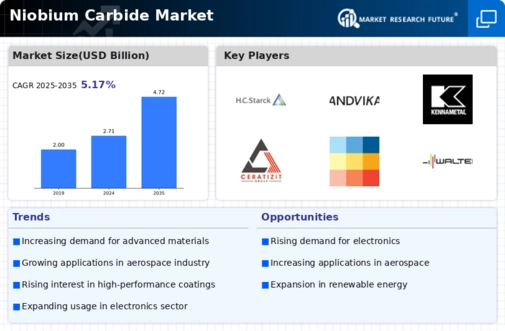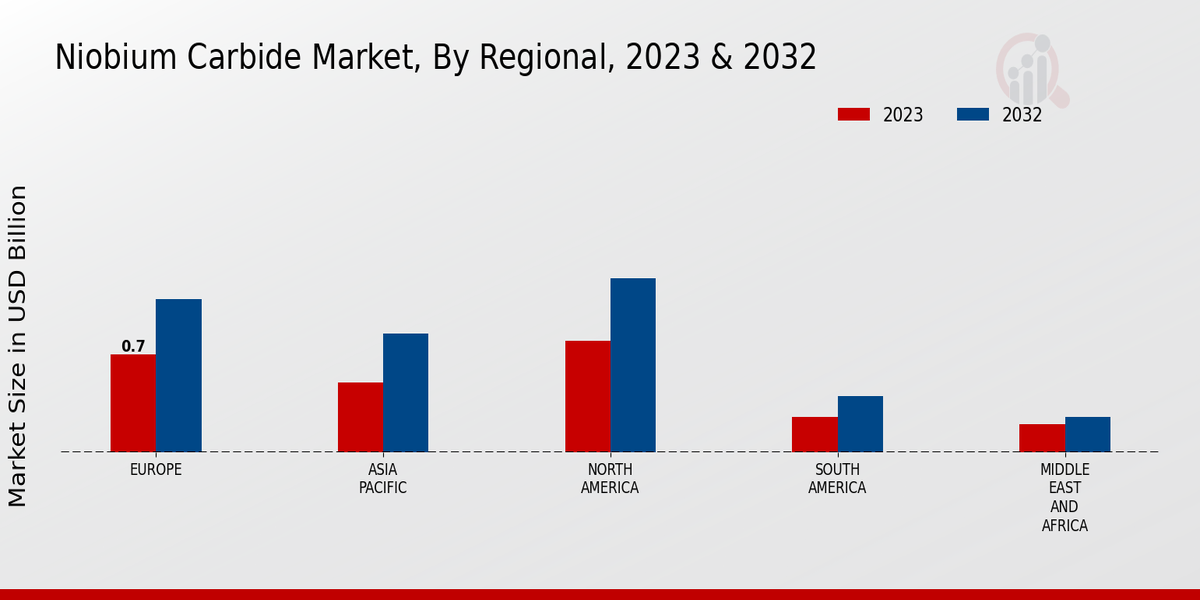Market Growth Projections
The Global Niobium Carbide Market Industry is projected to experience substantial growth over the next decade. With an estimated market value of 2.71 USD Billion in 2024, the industry is expected to expand to 4.72 USD Billion by 2035. This growth trajectory indicates a compound annual growth rate of 5.18% from 2025 to 2035, reflecting increasing demand across various sectors, including aerospace, defense, and electronics. The market's expansion is driven by technological advancements, rising applications, and a focus on sustainability, positioning niobium carbide as a critical material for future innovations.
Growth in Metalworking Industry
The Global Niobium Carbide Market Industry is significantly influenced by the expansion of the metalworking sector, where niobium carbide is employed to enhance the performance of cutting tools and machining processes. As manufacturers seek to improve efficiency and reduce production costs, the adoption of advanced materials like niobium carbide becomes increasingly attractive. The metalworking industry is projected to grow steadily, driven by technological advancements and increased production capacities. This growth is expected to support the niobium carbide market, with a compound annual growth rate of 5.18% anticipated from 2025 to 2035, indicating a promising outlook for the industry.
Increasing Applications in Electronics
The Global Niobium Carbide Market Industry is witnessing a surge in applications within the electronics sector, where niobium carbide is utilized for its excellent electrical conductivity and thermal stability. As the demand for high-performance electronic components grows, manufacturers are increasingly incorporating niobium carbide into their products. This trend is particularly evident in the production of semiconductors and advanced circuit boards, where the material's unique properties enhance performance and reliability. The expansion of the electronics market is anticipated to bolster the niobium carbide industry, further solidifying its role in modern technology.
Rising Demand in Aerospace and Defense
The Global Niobium Carbide Market Industry is experiencing heightened demand from the aerospace and defense sectors, where materials with superior hardness and thermal stability are essential. Niobium carbide is utilized in the production of cutting tools and wear-resistant coatings, which are critical for high-performance applications. As global defense budgets increase, particularly in regions such as North America and Asia-Pacific, the need for advanced materials like niobium carbide is expected to rise. This trend is likely to contribute to the market's projected growth, with an estimated value of 2.71 USD Billion in 2024, reflecting a robust demand trajectory.
Technological Advancements in Material Science
Innovations in material science are propelling the Global Niobium Carbide Market Industry forward, as researchers develop new applications and improve existing processes. Enhanced manufacturing techniques, such as additive manufacturing and advanced coating technologies, are expanding the utility of niobium carbide in various sectors, including electronics and automotive. These advancements not only improve the performance of niobium carbide products but also reduce production costs, making them more accessible to a broader range of industries. As these technologies evolve, they are likely to drive market growth, contributing to an expected market value of 4.72 USD Billion by 2035.
Environmental Regulations and Sustainability Initiatives
The Global Niobium Carbide Market Industry is also shaped by increasing environmental regulations and sustainability initiatives. As industries strive to reduce their carbon footprint and improve resource efficiency, the demand for eco-friendly materials is rising. Niobium carbide, known for its durability and longevity, aligns well with these sustainability goals, making it an attractive option for manufacturers. Companies are increasingly seeking materials that not only meet performance standards but also adhere to environmental guidelines. This shift towards sustainable practices is likely to enhance the market's growth prospects in the coming years.





















Leave a Comment